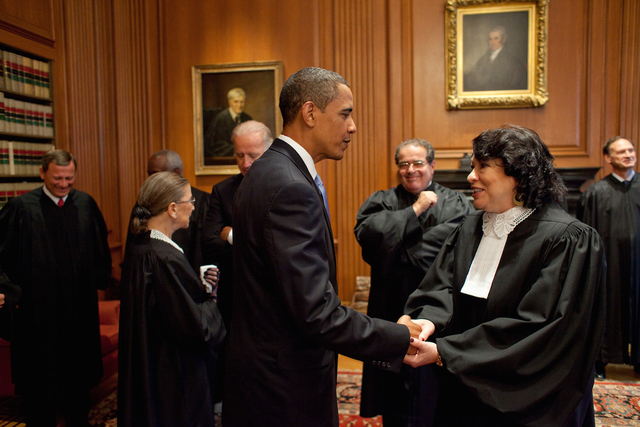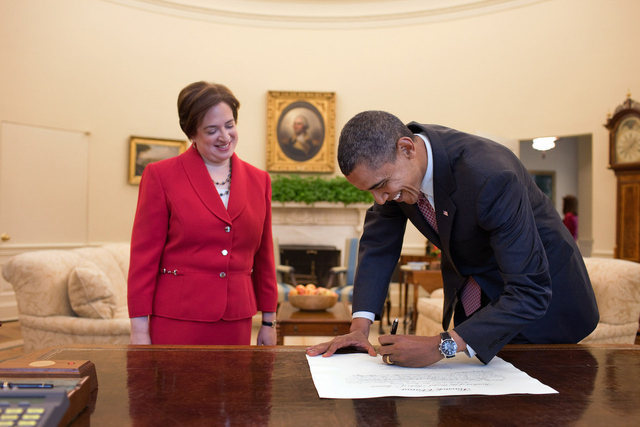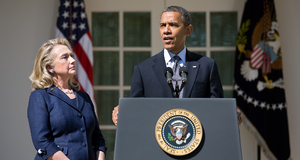The Obama PresidencyPredicting the Fate of the Judiciary After Obama
By
2015, Vol. 7 No. 02 | pg. 1/3 | »
IN THIS ARTICLE
KEYWORDS
One often-admired trait of the federal courts is their apolitical nature. Judges that are appointed for lifetime tenure do not face the pressures that come with reelection and trying to please constituents. While this may be true, much of the judiciary has its roots in politics – judges are nominated by the President and then confirmed by the Senate respectively, thus exposing them to the hyperpolarization of the current political system. Under the Obama Administration, the judiciary has provided a unique set of challenges and obstacles and will likely become a significant part of the Obama legacy. Obama initially ran for President promising bipartisan relations, but looking at the state of the judiciary under Obama’s administration serves to show how increasingly partisan politics in the United States has become. From the use of obscene delay tactics to the outright opposition to Obama’s judicial nominees, the Republican Party has wreaked havoc in the Senate and has attempted to completely undermine the Obama Administration and its agenda. The nature of this discussion will show how politics is, in fact, deeply engrained in the judiciary, becoming increasingly evident during times of extreme political polarization. 
President Obama with Justice Sonia Sototmayor immediately prior to her investiture ceremony at the Supreme Court (September 2008). Justice Elena Kagan with President Obama, signing her commission to the Supreme Court (August 2010). Photos: Pete Souza/White House. Despite the significant challenges that President Obama has faced making judicial nominations, he has managed to appoint a very unique set of judges to the various federal benches. From the firsts of several ethnicities, to the first openly gay judges on many benches, to a record number of women, Obama’s nominations have been groundbreaking and will continue to promote increased diversity in appointed federal offices. His success is surprising given the strong Republican opposition in the Senate, and is undoubtedly due to the Democratic majority in the Senate through 2014. The next two years, following the recent 2014 Midterm Elections, will prove very different for the Obama Administration in a number of ways. Now that this power shift has occurred and the Democratic Party will no longer maintain control of the Senate in 2015, judicial nominations will likely be greatly affected. Additionally with a number of Supreme Court Justices possibly gearing up for retirement, Obama’s history of successful appointees combined with the results of the 2014 Midterm Elections can be used to predict what the next Justice(s) will have to look like. If Obama is given another opportunity to nominate a Supreme Court Justice, he or she must be characteristically different from his Supreme Court appointees so far. The courts have a significant impact on the laws of our country, especially those that raise controversy. Furthermore, they provide a means through which people can seek justice – justice being an integral component of government and society in the United States. In the remaining two years of Obama’s presidency, he will continue to define his legacy. It is already evident that the federal judiciary will be a part of it; the question remains, however, as to whether it will be considered among his successes or failures. Republican OppositionRepublicans in Congress have taken it upon themselves to stand in staunch opposition to many initiatives proposed by the Obama Administration and Congressional Democrats. The judiciary has particularly suffered from the Republican’s obstruction and delay tactics.1 The hyperpolarization that has plagued politics becomes increasingly evident regarding judicial nominations. Seats on the District Court benches have historically been fairly easy to fill; unless something controversial comes up during the confirmation process, nominees were typically appointed without hitch.2 However, during President Obama’s Administration about 40% of the District Court nominees waited longer than 100 days for a Senate vote. Debate surrounding Circuit Court nominees has always been a longer process than with District Court nominees, but 69% of Obama’s nominees waited longer than 100 days for a Senate vote compared to President Bush II’s 15%.3 Increasing VacanciesTypically with both District Court and Circuit Court nominations, Senators from the respective states and regions will make recommendations to the White House and Senate Judiciary Committee. Following the 2010 Midterm Elections though, this practice changed.4 The Republicans stopped making such recommendations, despite President Obama’s previous willingness to nominate recommendations from Republicans.5 There is a tradition on the Senate Judiciary Committee in which nominees aren’t processed to proceed with confirmation if they are not supported by the Senator(s) from their respective states.6 This has contributed to delaying the nominations process and has left many vacancies on the benches of the lower federal courts. In many cases, there has been almost no point in making a nomination, knowing that a Senator will oppose any nominee from President Obama.7 According to the White House, vacancies in the federal courts have been continuously on the rise since President Obama took office in 2009. At the time there were fifty-five vacancies and in the 2013 report that number had risen to ninety-one. That amounts to a vacancy in one out of every ten federal judgeships.8 Vacancies have been on a constant rise during the Obama Administration. This is unique, as both President George W. Bush and President Clinton saw the number of vacancies decline over their time in office.9 Leaving vacancies in the courts reflects poorly on the Obama Administration, as it will appear as though the President is failing to fulfill his Constitutional obligations. Vacancies on the federal benches mean that there are fewer judges to hear cases, subsequently meaning that the courts will hear fewer cases. People will be forced into a position of either waiting an exuberant amount of time for their case to be heard, or risk the courts not hearing the case at all. Civil cases have by far suffered the most from this. In 2010, 15.9% of federal civil cases waited over three years for a resolution to be reached; this was up from only 6.6% in 2006.10 In the eye of the public, this will be construed as a failure of the justice system as a result of President Obama’s inability to work with Congress. The FilibusterSheldon Goldman, a scholar of judicial nominations, points out some troubling statistics. During his first term, President George W. Bush had an 87.5% success rate regarding his nominations to the judiciary; during Obama’s first term, he had a 68.8% success rate. President Bush was working with a Democratic majority in the Senate during his first two years, while Obama maintained a Democratic majority throughout his first term. This majority wasn’t large enough, though, to combat the Republican’s frequent use of the filibuster.11 As a result of Republicans’ continuous attempts to block judicial nominations, the Senate Democrats decided to take a more drastic course of action. In November 2013 they voted to change the filibuster rule so as to prevent the Senate Republicans from creating obscene delays and obstructions in the confirmation process. Instead of sixty votes being required in order to end debate, under the new rules only a mere majority is needed. This does not apply to debate surrounding legislation or nominations to the Supreme Court.12 Following the passage of the filibuster rule change, President Obama addressed the public and said: All too often we’ve seen a single Senator or handful of Senators choose to abuse arcane procedural tactics to unilaterally block … or to prevent well-qualified patriotic Americans from filling critical positions of public service in our system of government.[13] This serves to show his frustration with the process of judicial nominations during his Presidency. On many occasions, individual or small groups of Tea Party Republicans would take advantage of a particular provision allowing for the individual review of nominees before Senate proceedings can go forward, meaning that the individual Senator has the power to hold up nominations.14 Prior to passing the anti-filibuster legislation, President Obama’s nominees tended to be more moderate, so as to avoid a political uproar and significant opposition. He wanted to minimize his chances of facing delays and obstruction during the confirmation process. Following the passage of the legislation, nominees were much more liberal and progressive than they were previously. Historic SuccessesNotwithstanding the many challenges that President Obama has faced when nominating people to the federal courts, those that he has succeed in appointing to the various benches have been a very diverse set and the White House has prided itself on this accomplishment. Likewise, there has been a huge shift in judicial ideology that can be seen in the Circuit Courts and will have a lasting impact on the judiciary. Increased DiversityJeffrey Toobin puts it best by saying, “Obama’s judicial nominees look different from their predecessors.”15 He has succeeded in appointing more non-traditional people to the bench than any previous president and subsequently has been significantly diversified.16 Obama has made it a huge priority to create a judiciary that resembles the population that it works for. In an interview for The New Yorker, President Obama said: I think there are some particular groups that have been under-represented – like Latinos and Asian Americans – that represent a larger and larger portion of the population. And so for them to be able to see folks in robes that look like them is going to be important.[17] The ideological shift that we have experienced in America, regarding our more open attitudes towards people of ethnic minorities, is becoming a visible shift within branches of the government, particularly in the judiciary due to President Obama’s initiatives. The statistics back up this claim. President Obama appointed the first South Asian American Circuit Court Judge. Additionally, he appointed the first African American Circuit Court judge in five states and the first Hispanic Circuit Court judges in three Districts. He has doubled the number of Asian Americans appointed to the judiciary, and has appointed the only active Asian American judges serving on the Circuit Courts. He also appointed the first women of varying Asian descents to the federal benches.18 Not only has President Obama worked to increase the representation of ethnic minorities in the judiciary, but he has also sought to decrease the gender gap. Of President Obama’s confirmed judges, 41% have been women; this is an incredible increase up from Clinton’s 29% and Bush II’s 22%.19 This serves to significantly reduce the gender gap in the judiciary and make the composition of judges much more representative of the country’s population. According to the US Census Bureau, in 2010 women accounted for just over 50% of the population20; while Obama has significantly reduced the gap, it is worth noting that women do remain in the minority. Both of President Obama’s Supreme Court appointees were women, with Justice Sonia Sotomayor also being the first Latina on the Supreme Court and the first Justice to have a disability. Justices Sotomayor and Kagan make up half of the women to ever be appointed to the Supreme Court, Justices O’Connor and Ginsburg preceding them.21 Furthermore, three of the four women are currently serving on the Supreme Court bench together among the six other men.22 Another important group to acknowledge is openly gay judges. President Obama notes in an interview with Jeffrey Toobin that in 2009 when he first took office, there was only one openly gay judge. His administration has succeeded in appointing ten additional openly gay judges.23 Gays in the military and marriage equality have both been highly controversial issues that the Obama Administration has faced in one form or another. By actively appointing gays to the judiciary, he is taking a stance supporting equality among varying sexual orientations. Circuit Court ShiftThe Circuit Court of Appeals is often overlooked in importance because it is not the highest court in the United States. However it is extremely important to note that the Supreme Court will only hear about seventy-five cases in a year, while the Circuit Courts will hear and issue decisions on thousands of cases. This means that more often than not, the Circuit Court holds the final word in many, sometimes controversial, areas of law until the Supreme Court chooses to rule on the issue.24 When President Obama first took office in 2009, ten of the Circuit Courts had a majority of judges that had been appointed by a Republican president and only two had a majority appointed by a Democrat. Now, only five and a half years later, nine of the Circuit Courts have a majority of judges that have been appointed by a Democratic president and only four have a majority appointed by a Republican.25 This shift was not necessarily surprising; many scholars had predicted a change early on in the Obama Presidency.26 The surprise came with how significant and how quickly the shift occurred. Essentially, the Democrats and their appointed judges have the ability to control important decisions in those Circuit Courts if they choose to exercise that ability.27 Because federal judges have life tenure, these judges are likely to serve on the Circuit Courts long after President Obama leaves office. Already, there are significant implications in the Circuit Courts. For example, in July 2014, the D.C. Circuit Court ruled in Halbig v. Burwell that subsidies given for insurance purchased through the federal health insurance exchange went against the language of the law itself, and therefore such subsidies could not be given. This decision had the potential to become very threatening to the Affordable Care Act. The D.C. Circuit Court is among the courts that have seen a shift from a Republican majority to a Democratic majority. Because of this, President Obama asked the Court to vacate the decision of the panel and to hear the case en banc; the Court agreed, and now Obama will have the majority support that he needs to uphold the Affordable Care Act so long as it is not appealed to the more polarized Supreme Court.28Continued on Next Page » Suggested Reading from Inquiries Journal
Inquiries Journal provides undergraduate and graduate students around the world a platform for the wide dissemination of academic work over a range of core disciplines. Representing the work of students from hundreds of institutions around the globe, Inquiries Journal's large database of academic articles is completely free. Learn more | Blog | Submit Latest in Political Science |

















